ISLANDS
- side two -
- chapter index -
pg. 1 - Ladies of the Road | pg. 2 - A Flower Lady's Daughter | pg. 3 - Taming the Ox
pg. 4 - Prelude : Song of the Gulls | pg. 5 - Returning Home | pg. 6 - Islands
pg. 7 - Earth, Stream and Tree | pg. 8 - Beneath the Wind Turned Wave | pg. 9 - Dark Harbor Quays
pg. 10 - The Ego and the Self | pg. 11 - Magnum Opus
page index
Sailor's Words | The Pearl of Great Price | Return to the Sea | Quaternity
site index
Translate from
"Dark harbour quays like fingers of stone
Hungrily reach from my island."
In verse three the narrator moves from the passive non-resistance of verse two to "hungrily" seeking contact with his own unconscious. "Fingers of stone" belong to a "man of stone" who, by extension, also has a "heart of stone".
"The most malignant reason why the heart does not develop is because the individual hardens his heart or, as in myths and dreams, replaces it with stone. The heart becomes perverted as the will is directed toward power.... Other people are used as objects or as puppets.
For such people, repentance requires a total change of heart. They must change their minds, intentions, and actions. This requires the willingness to experience full self-disgust and turn to a new path."
- Michael Maccoby,
The Gamesmen: The New Corporate Leaders
"Fingers of stone" further suggest that, without access to the sea of his own hidden thoughts, he feels stiff and fossilized (dogmatic). "Dark harbor quays" reach into the dark places, telling us that our narrator needs the illumination that comes via the unconscious.
return to page index
site index
"Clutch sailor's words - pearls and gourds
Are strewn on my shore
Equal in love, bound in circles."
He is the sailor and, as it is "words" from the unconscious (expressing thoughts, feelings and sensations) that he most values ("clutches"/contemplates), the "sailor" is a poet. The sailor is Peter Sinfield. A painter studies images and a musician sounds, but a poet or writer must consider the meaning of his own words. By contemplating the "words" rising up into consciousness he comes to better know himself. He furthers the process of individuation.
"Individuation can take the form of a process experienced as an 'individual way' (e.g., analysis, creative writing or painting)
- Individuation: The Process of a Lifetime
Howard W. Tyas, Jr
"As a spiritual path, Sufism has reflected itself in different shapes, colors and dimensions through different art mediums. All these different images have ultimately pointed in the same direction: the self. Through art, Sufism functions in a circular manner which begins with the artist, and ends with him/her again."
- Mercan Dede
Sufi Dreams
The "words", as "pearls and gourds", represent the high and the low the best and the worst of him but they are "equal in love", he must consider them all. For it is only love (acceptance) of the beautiful and the ugly (the nymph and the harvest hag) that erodes the "high weathered walls" of his ego. If he denies any part of the unconscious he denies who he is and he lives the counterfeit life of the ego.
"The great problems of life . . . are always related to the primordial images of the collective unconscious. . . .
The unconscious is not just evil by nature, it is also the source of the highest good; not only dark but also light, not only bestial, semihuman, and demonic, but superhuman, spiritual, and, in the classical sense of the word, "divine."
- Carl Gustave Jung
The Psychology of the Transference, p. 28
return to page index
site index
"When the dark inner world calms down, the emotions of love become quiet, one finds the stone on the shore of the sea. The secret of individuation (the stone) is washed up on the shore of the unconscious, suddenly revealed by the grace of God."
- Marie-Louise von Franz
comment on Muhammad Ibn Umail's HALL AR-RUMUZ (Clearing of Enigmas)
"Know that the soul, the devil, the angel are not realities outside of you: you are they. Likewise, Heaven, Earth, and the Throne are not outside of you, nor paradise nor hell, nor death nor life. They exist in you; when you have accomplished the mystical journey and have become pure you will become conscious of that."
- Najmoddin Kobra, 13th C. Sufi Philosopher
"The journey to the height of reality is also the journey within oneself. And just as one cannot scale the heights without first coming to terms with the rubble that litters the foot-hills, so one cannot come to the pearl of great price, the soul, that lies deep within each of us until one has first encountered, mastered, and transmuted the dark elements of the unconscious that obscure the inner light."
- Precarious Living
by Dr. Martin Israel
"The alchemists had an excellent image for the transformation of suffering and symptom into a value of the soul. A goal of the alchemical process was the pearl of great price. The pearl starts off as a bit of grit, a neurotic symptom or complaint, a bothersome irritant in one's secret inside flesh, which no defensive shell can protect oneself from. This is coated over, worked at day in day out, until the grit one day is a pearl; yet it must still be fished up from the depths and pried loose. Then when the grit is redeemed, it is worn. It must be worn on the warm skin to keep its luster: the redeemed complex which once caused suffering is exposed to public view as a virtue. The esoteric treasure gained through occult work becomes an exoteric splendor."
- James Hillman
The "esoteric treasure", the "virtue" which Peter Sinfield has "exposed to public view" are his words.
"Art is a kind of innate drive that seizes a human being and makes him its instrument. The artist is not a person endowed with free will who seeks his own ends, but one who allows art to realise its own ends through him. As a human being, he may have moods and a will and personal aims, but as an artist he is 'man' in a higher sense - he is 'collective man' - one who carries and shapes the unconscious, psychic life of mankind. To perform this difficult office it is sometimes necessary for him to sacrifice happiness and everything that makes life worth living for the ordinary human being."
- Carl Gustav Jung
Modern Man In Search Of A Soul
And not only is Peter Sinfield's art (his poetry) the means by which he knows himself it is also the outcome of the individuation process.
"What is it in the end, that induces a person to go his own way and to rise out of unconscious identity with the mass as out of a swathing mist? Not necessity, for necessity comes to many, and they all take refuge in convention. Not moral decision, for nine times out of ten we decide for convention likewise. What is it, then that inexorably tips the scales in favor of the extraordinary? It is what is commonly called vocation: an irrational factor that destines a person to emancipate himself from the herd and from its well-worn paths. True personality is always a vocation and puts its trust in it as in God . . . But vocation acts like a law of God from which there is no escape. . . . He must obey his own law, as if it were a daemon whispering to him of new and wonderful paths. Anyone with a vocation hears the voice of the inner person: he is called."
-- C. G. Jung
"If you observe a really happy man you will find him building a boat, writing a symphony, educating his son, growing double dahlias in his garden, or looking for dinosaur eggs in the Gobi desert. He will not be searching for happiness as if it were a collar button that has rolled under the radiator. He will not be striving for it as a goal in itself. He will have become aware that he is happy in the course of living life twenty-four crowded hours of the day."
- W. Beran Wolfe
return to page index
site index
"Earth, stream and tree return to the sea
Waves sweep the sand from my island,
from me."
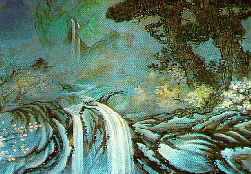
"So the ninth picture is Returning to the Source, and it shows a stream and a tree. There's no man, no animal, and it's called Returning to the Source. The commentary says, "Abiding in motionless serenity, I observe the rising and falling of things." It's a pure natural energy, awareness of going back to the origin where the spring originates. The root of the tree, the source of the water."
- Ralph Metzner
"Each separate being in the universe returns to the common source. Returning to the source is serenity. If you don't realize the source you stumble in confusion and sorrow. When you realize where you come from you naturally become tolerant."
- Lao Tzu
"All the rivers run into the sea, but the sea is not full; unto the place from whence the rivers came, thither they return again."
- Ecclesiastes 1:7
"....the ocean is always the symbol of the collective unconscious. It is an all embracing general symbol, and the self....is also the ocean....So the Self is the whole collective unconscious, the origin and the end of life, the origin of rain and of all the rivers, of the whole universe, the end of all distinctiveness."
- Nietzsche
Thus Spoke Zarathustra p.71
"The four psychological functions represent a circular and sacred pattern, like the hands of a divine and extraordinary clock going round and round in the moments of our everyday, ordinary life. Each function is designed to complement the other, and each contributes to the birth and death of the other, wired with an invisible and indestructible thread that connects us to the ground of our Being, which was always there and will always be there."
- The Genesis Model
by Gerry Anne Lenhart
return to page index
site index
"Out of the turmoil and terror of our life the one precious flower of the spirit begins to unfold, the four-petaled flower of the immortal light, and even if our mortal consciousness should not be aware of its secret operation it nevertheless does its secret work of purification."
- C. G. Jung
Memorial to J. S., Collected Works, Vol. 18.
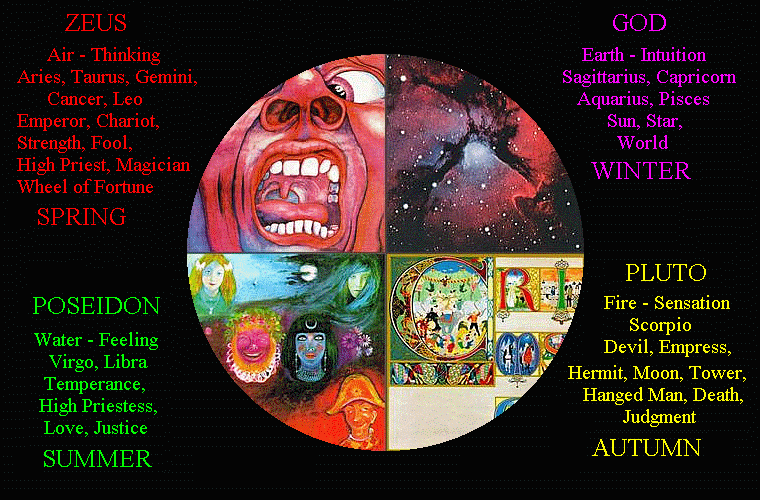
"In air, fire, earth and water
World on the scales.
Air, fire, earth and water
Balance of change
World on the scales
On the scales."
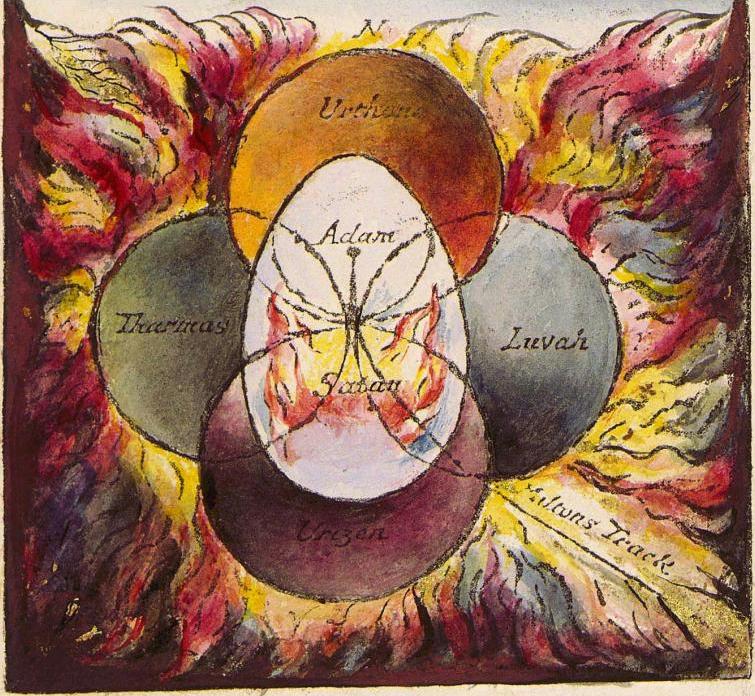
William Blake's Four Zoas
"There are four great ‘daimons’ or god-figures who appear in much of his major work, called the Four Zoas. Occasionally the names change but the meaning is generally clear. They correspond to those divisions of psychological functioning described by Jung. Los or Urthona (corresponding to Intuition) is the Spirit of Prophecy, the divine vision, a figure similar to the classical Phoebus Apollo. The name possibly derives from Sol (sun) spelled backwards, or from ‘earth-owner’. Urizen (corresponding to Thinking) and perhaps derived from ‘your reason’ is the Spirit of Thought, Eternal Mind; his ‘steeds’ are thoughts. The silver mountains of Urizen are where wisdom dwelt. He is also a law giver, and in some ways similar to Zeus. Luvah or Orc (corresponding to Feeling) is Prince of Love, Eros, Eternal Youth , sometimes called Red Orc -- the fiery boy. The names derive possibly from ‘lover’ or ‘hawk of May’. Tharmas (corresponding to Sensation) represents the corporeal Waters of Matter, the fluid matrix of form. He appears as a kind of great demon of the waters, a Neptune or Poseidon figure."
- Ritual Magic
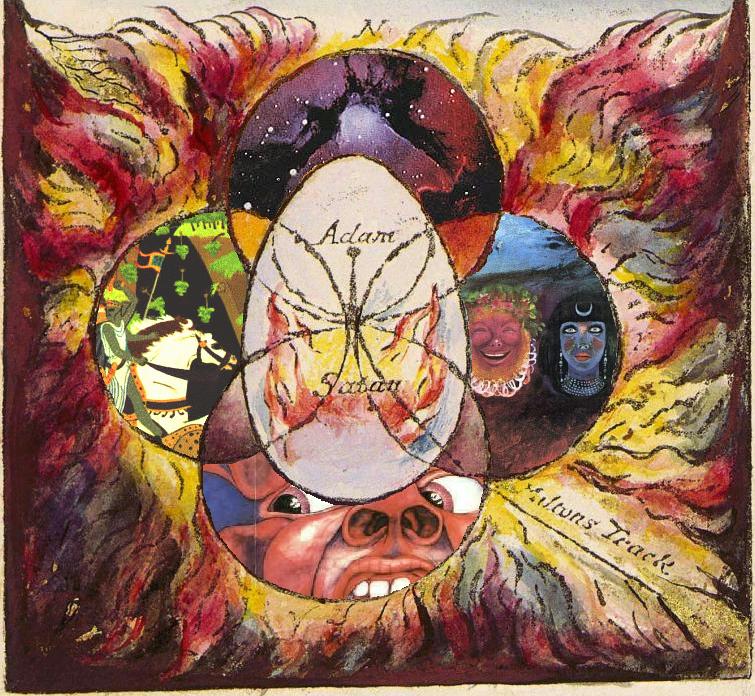
Note that these four states also correspond to the four worlds of the Kabbalistic Tree of Life and to the four elements :
| Atziluth (Emanation) | Fire | Intuition | The Self |
| Briah (Creation) | Air | Thinking | Language, Abstraction, Reason |
| Yetzirah (Formation) | Water | Feeling | Emotions, Drives, Feeling |
| Assiah (Action) | Earth | Sensation | Perception, Imagination, Instinct, Reproduction |
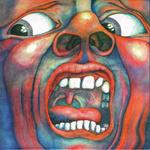 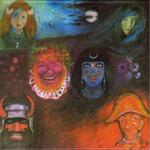 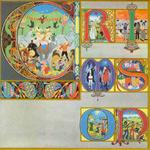 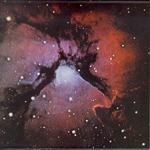
|
 "If the World of Emanation is Spiritual, then the World of Creation is Mental. This is the realm of the Higher
Mind, the final stop for Reason; this is as high as we can ascend through our intellectual being. Somewhat
incongruously, then, this is the realm of the Throne-Chariot glimpsed by Ezekiel and the Merkabah- mystics,
with its opulent imagery, its gorgeous and mysterious (and rather frightening) angelic guardians; of the
heikhalot, the seven halls or palaces; of the serafim, the prince-angels. Beriyah is a repository of visionary
splendor."
"If the World of Emanation is Spiritual, then the World of Creation is Mental. This is the realm of the Higher
Mind, the final stop for Reason; this is as high as we can ascend through our intellectual being. Somewhat
incongruously, then, this is the realm of the Throne-Chariot glimpsed by Ezekiel and the Merkabah- mystics,
with its opulent imagery, its gorgeous and mysterious (and rather frightening) angelic guardians; of the
heikhalot, the seven halls or palaces; of the serafim, the prince-angels. Beriyah is a repository of visionary
splendor."
|
 The third world is that of Formation, yetzirah. Formation is a bringing together of elements, rather than a
creation ex nihilo. This is the emotional realm. If beriyah is the psychological realm of consciousness, yetzirah is
the unconscious mind. Not surprisingly, the element of water (a common symbol of the unconscious and of
emotion, as Carl Jung pointed out) is associated with this realm; shadowy currents move here; monsters may
live in the deep water.
The third world is that of Formation, yetzirah. Formation is a bringing together of elements, rather than a
creation ex nihilo. This is the emotional realm. If beriyah is the psychological realm of consciousness, yetzirah is
the unconscious mind. Not surprisingly, the element of water (a common symbol of the unconscious and of
emotion, as Carl Jung pointed out) is associated with this realm; shadowy currents move here; monsters may
live in the deep water.
|
Finally, we come to the fourth world, assiyah. This is commonly called the World of Action, but Scholem
suggests that the World of Making is a more appropriate translation (Major Trends, p.272). This is making in
the sense of completing what has been started in the upper worlds; the roots and branches are in the upper
worlds, but it is in assiyah that things come to their fruition.
 This is the physical realm, but it has two aspects. It is "the spiritual archetype of the material world of the senses" (p. 272), which, for Luria, became confused with the world of the Shells (kelippot) on account of Adam's fall (Encyclopedia Judaica, v.16, col. 642). It thus has its brute material aspect, the world directly accessible to our senses. It is enlivened by nefesh, the vital principle, a soul-element possessed by plants as well as animals. Earth is its representative element, scarlet its color, the color of blood, sustainer of the material body. Assiyah is the place of the Shekhinah's exile. The Massekhet Atzilut also describes it as being the abode of the Satanic figure of Samael, the Blind One, the husband of Lilith, though later Kabbalists consign the demonic to an even lower realm. |
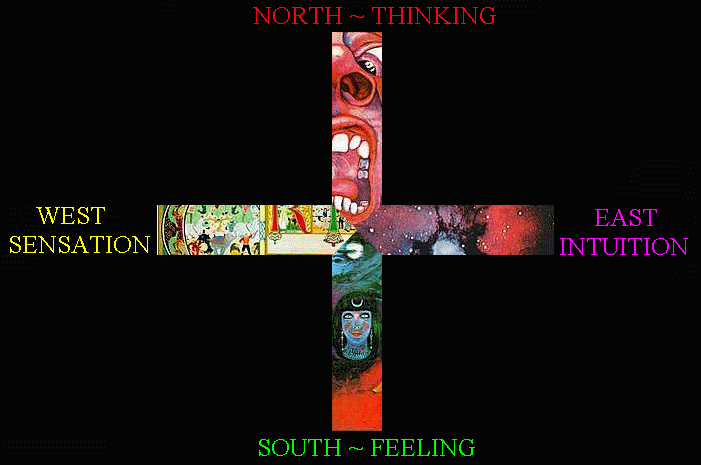






















 Arachnophilia
Arachnophilia